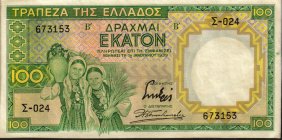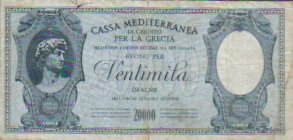Some Anomalies Found on Greek Bank Notes
 From a numismatic perspective Greek bank notes of the period 1939 to the end of World War II are interesting as they contain a number of anomalies not found elsewhere. These include error notes, overprints, design changes on the same note, watermarks, under-print variations and above all, the phenomena of identical series and series numbers which are commonly found on notes of the German occupation series. Some of these abnormalities can be explained, while others still remain a mystery.
From a numismatic perspective Greek bank notes of the period 1939 to the end of World War II are interesting as they contain a number of anomalies not found elsewhere. These include error notes, overprints, design changes on the same note, watermarks, under-print variations and above all, the phenomena of identical series and series numbers which are commonly found on notes of the German occupation series. Some of these abnormalities can be explained, while others still remain a mystery.
Click to download PDF here.
Italy's Colonial Empire - A Paper Money Trail

This, the thirty-second in our series of articles on paper money, is the story of how Italy aspired to build a colonial empire of its own - and in large part succeeded.
Being one of the last European countries to unify in 1870, Italy was late in arriving to the "scramble for Africa" wherein other powers, notably Great Britain and France, were expeditiously establishing new colonies on the African continent. Shortly after unification, a wave of nationalism swept across Italy. Italians yearned for the past glory of the Roman Empire which, by 30 BC, had conquered all the lands surrounding the Mediterranean. They felt that much of this old territory was rightfully theirs. When Benito Mussolini came to power in 1922 as Italy's absolute dictator, he played upon this theme. The old Roman notion of Mare Nostrum (Our Sea) almost became a reality. Mussolini was bent upon pushing his 'Greater Italy' all the way across Africa from Tunisia, through Egypt and the Sudan to Italian East Africa on the Indian Ocean before the British stopped him at El Alamein, thus ending Italy's quest for an Italian Empire forever.
Click to download PDF here.